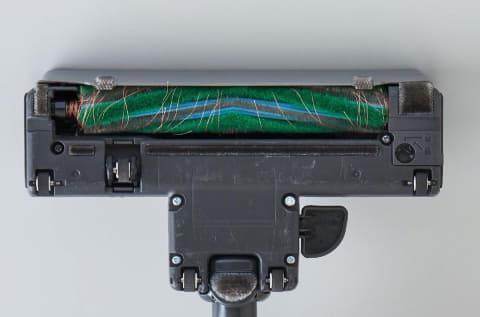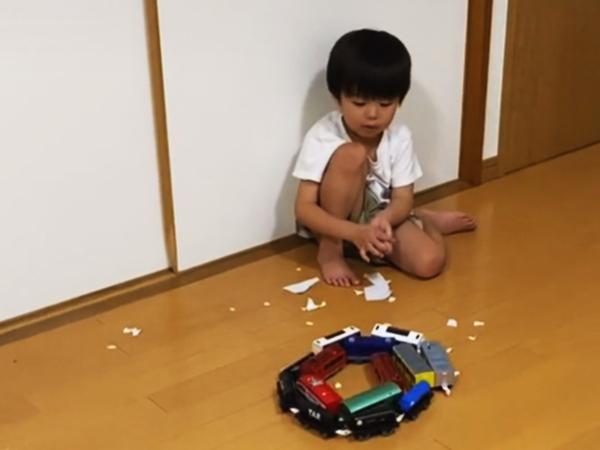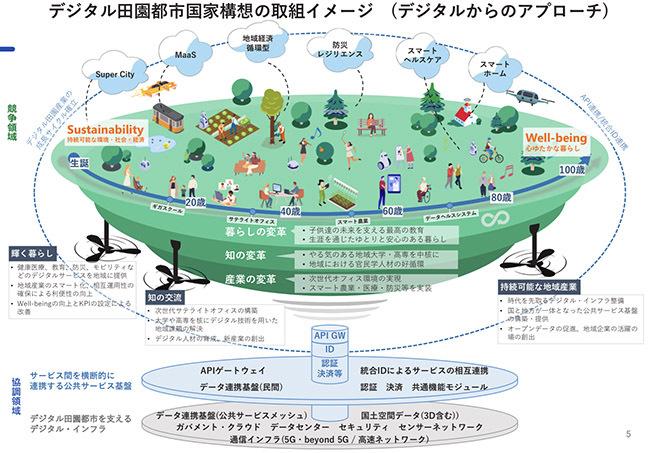Revolutionary vacuum cleaner, Panasonic "Power Cordless" with a brush that does not tangle and is strong against hair and pet hair
Here's an explanation for those who can't believe that the hair really doesn't get tangled. After all, the technological innovation around the head is the first in 53 years since the brush was added.
It's mainly for engineers, so if you think "If you know the result, that's fine!", you can skip to the next section.
The mechanism itself is very simple. Something that uses the familiar laws of physics that can be patented instead of a utility model. I want you to watch the slow motion video first.
"Untangled" slow motionWhat you can see is the shape of the brush. A brush is usually attached to one cylinder. But the power cordless has two conical brushes with tapered ends. Furthermore, each brush is independent on the left and right, and the central part is completely separated.
There are cone-shaped brushes on the left and right, and there is a gap in the center for sucking in the hair.By doing this, hair and pet hair tangled in the brush will be drawn to the thinner tip as the brush rotates. It is collected and finally sucked into the suction port through the gap between the two brushes. It's a super simple mechanism, but it's an idea that no one has thought of for 53 years.
However, the difficult thing about home appliances is that you can't turn them into products with just an idea. Looking at the previous photo, the edge of the cone hits the tip of the head. Not only that, but the entire surface of the conical rim hits the floor.
The edge of the cone is attached so that it touches the front and floor of the headTherefore, the base of the cone is supported by tilting up and down and left and right at both left and right ends. This large conical brush is supported on one side by the motor part about 2cm on the left and right. It's fine if it's flooring, but it also cleans long-pile rugs and carpets, so each brush has a considerable load. Therefore, a metal shaft is embedded in the brush to prevent shaft vibration.
I disassembled the head part. It's just amazing to see the many bloody heads of the engineers! It uses anti-degradation screws, so the general public can't take it apart. Also, please note that it is not covered by the manufacturer's warrantyIn addition, the brush must be supported diagonally. This is also difficult to design, and since the brush is thicker than ever, the load is large, and the strength to support it at the base is also required. In order to create a product that will not break even after years of use and that does not break even with some impact, it is not possible to commercialize it with the idea of "a conical brush!"

In addition, another important mechanism is required to bring the hair to the center. That's the Teflon tape on the head cover (the slippery sticker on the back of a computer mouse). Pet hair and hair are pulled between the floor surface and the brush and gradually move toward the center, but if the slide is too good, it may not move toward the center. This Teflon tape assists in gathering them securely in the center. Moreover, if you can see the gray Teflon tape, it's a bad design, so I intentionally hide it with black tape to hide it (laughs)
Teflon tape on the back of the head cover. Even without a cover, if there is enough friction between the floor and the thread, the thread will come to the center of the brush.Those who are familiar with vacuum cleaners say, "Normal brushes have many types of bristles, such as those for flooring and carpets, but Panasonic only has one." It would seem There is actually a reason for this. As for general brushes, soft brushes for flooring are more flocked, and hard brushes for rugs are less flocked. Some of them are elaborate, such as adding rubber for hair dust and silver threads to prevent static electricity.
The problem here is a stiff brush for rugs. Because there are few flocks, hair tends to get caught in the gaps of the brush. To put it simply, it acts like a comb and gets more and more hair involved.
common brush. A non-tangling brush that alternates between thick, soft bristles and thin, hard bristles. You can't tell by looking, but the center of one brush has hard bristles and soft bristles are sandwiched between them. What's more, the amount of bristles is unusually large.Panasonic's "non-tangling brush" has the same color, so it looks like only one kind of bristles. A hard brush is sandwiched between soft flooring brushes. Moreover, you can see that the amount of hair transplanted is large.
This will prevent the hairs from getting between the stiff hairs. Moreover, since the amount of flocked hair is large, pet hair and hair do not dig into the back of the brush and are always stuck to the surface.
With conventional brushes, the threads are wedged between the brushes with hard gray bristles (for rugs). If you hold it down with Teflon tape, the bristles will move along the surface of the brush. Moreover, unlike Panasonic's brushes, the bristles are planted diagonally, but Panasonic's bristles are planted in a V shape, so the dust caught at the end of the head is collected in the center of the suction port. This is actually a Panasonic patent.The bristles of the brushes other than Panasonic are slanted. Panasonic has developed V-shaped bristles in their previous models. Scrape the debris caught at the edge of the head to the centerNext, look at the new 'non-tangling brush', the cone is attached at an angle, resulting in the same effect as V-shaped flocking. You get it. Awesome!
Because it is a cone-shaped brush, if you leave the suction central part as it is, a large space will be created, which will slow down the air flow and reduce the degree of vacuum. Therefore, by creating a protrusion in the center of the back of the head and a dent in the upper part of the head, airflow and air pressure are adjusted so that dust can be properly absorbed. Since there is a gap between the brushes in the center of the cover, a V-shaped wing is provided to compensate for this gap and is devised so that the dust in the center is not missed.
In the center of the back surface of the head, there is a recess in the center, which is not found in ordinary cleaners, when viewed from the front of the head with a convex airflow control plate, which is not found in ordinary cleaner heads. This is also the part where the airflow control brush has a gap, so the degree of vacuum is low, so the blade for airflow control is attached. It's a brush that doesn't stick.By increasing the number of motors for the brushes to two, by increasing the load on the brushes by increasing the diameter of the brushes, and by increasing the function of pressing the brushes with a certain force and pulling the thread waste to the center, From an engineer's point of view, it can't be helped that the driving time is slightly shorter than the previous power cordless. Surprisingly, it only lasted a few minutes.
There will be many requests to sell only "non-tangling brushes" for the previous power cordless. Unfortunately, it is not compatible with previous models, as it draws more current into the head.

![[Amazon first sale] HiKOKI's cordless cleaner is 54% off for 9,999 yen Lightweight, compact and easy to clean model (1/2 page)](https://website-google-hk.oss-cn-hongkong.aliyuncs.com/drawing/article_results_9/2022/3/28/4f7e7e487efd9ef22ec68bec06535756_0.jpeg)


![[EV's simple question ③] What is good for KWH, which represents the performance of the battery?What is the difference from AH?-WEB motor magazine](https://website-google-hk.oss-cn-hongkong.aliyuncs.com/drawing/article_results_9/2022/3/9/b2506c4670f9f2cb45ffa076613c6b7d_0.jpeg)
![[How cool is the 10,000 yen range?] 1st: The performance of the "robot vacuum cleaner with water wiping function (19800 yen)" like Rumba is ...](https://website-google-hk.oss-cn-hongkong.aliyuncs.com/drawing/article_results_9/2022/3/25/5251bb14105c2bfd254c68a1386b7047_0.jpeg)

